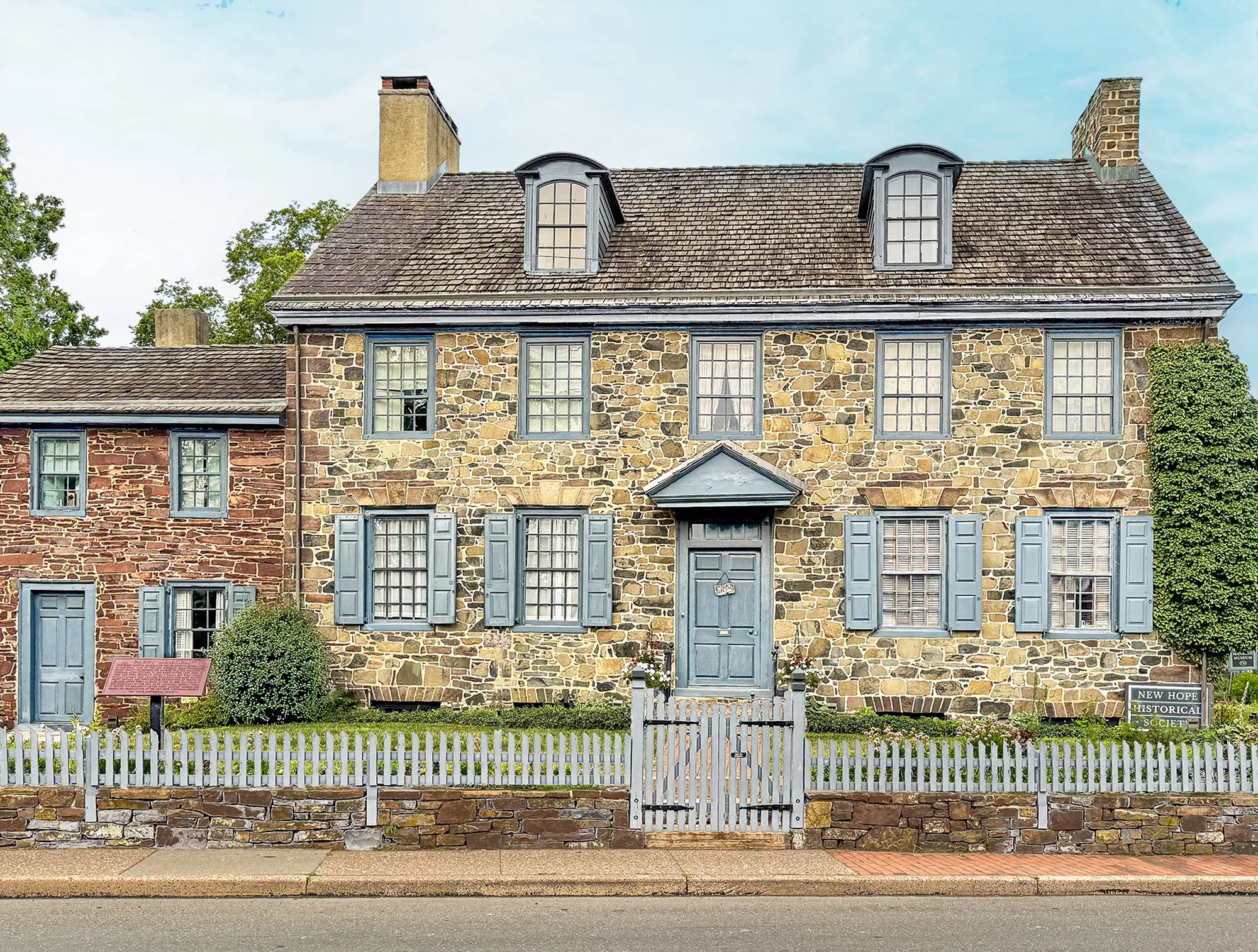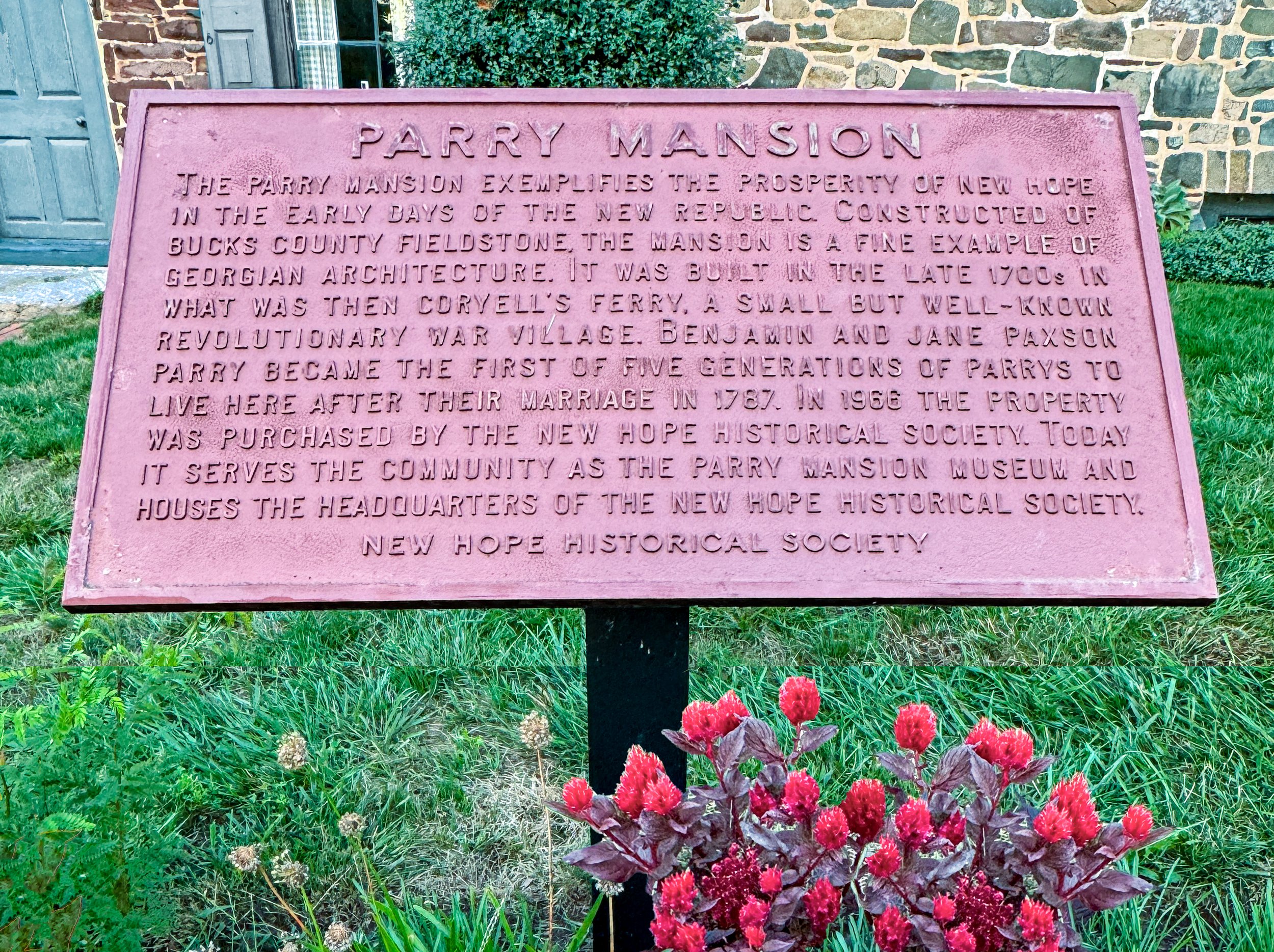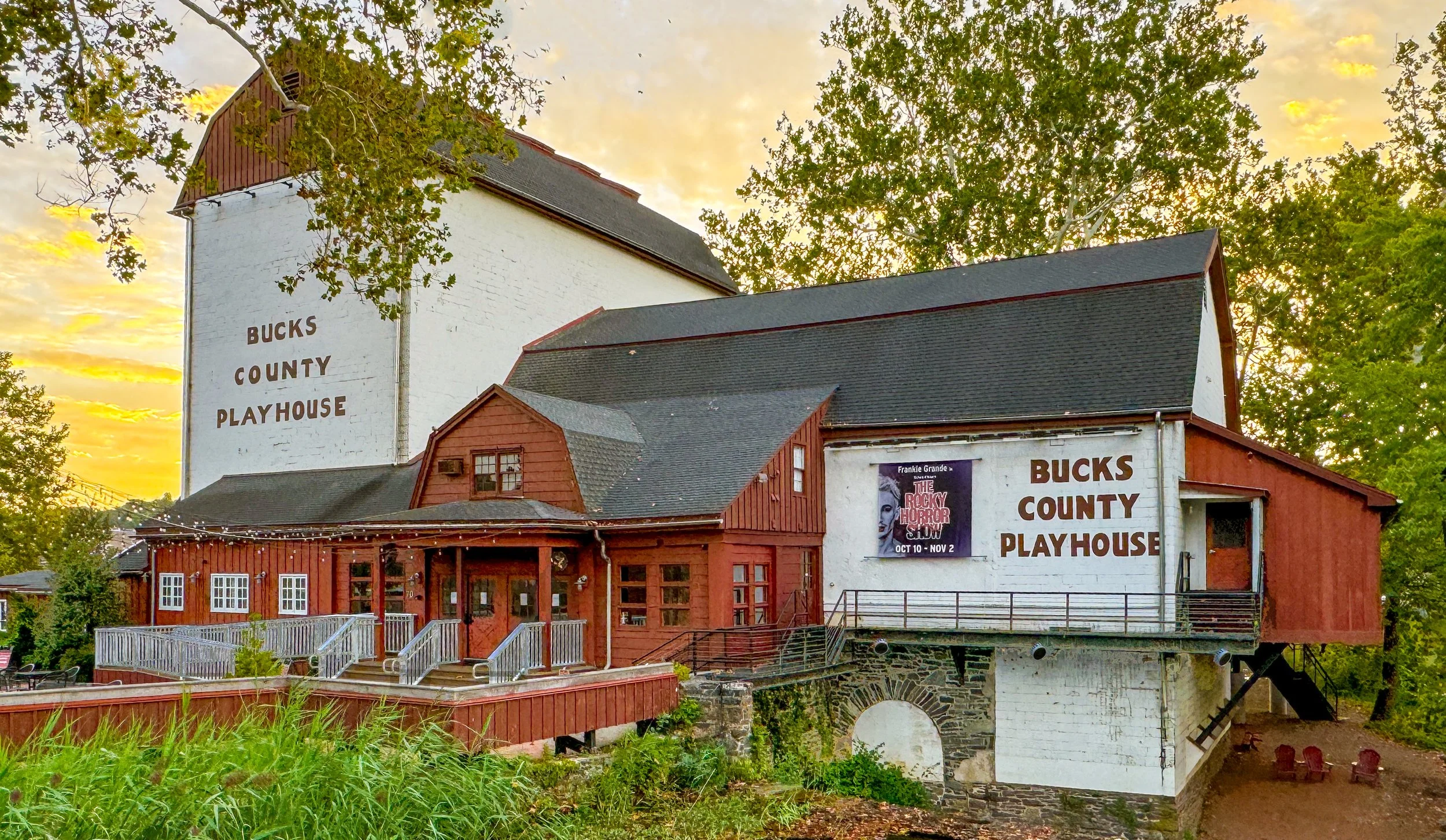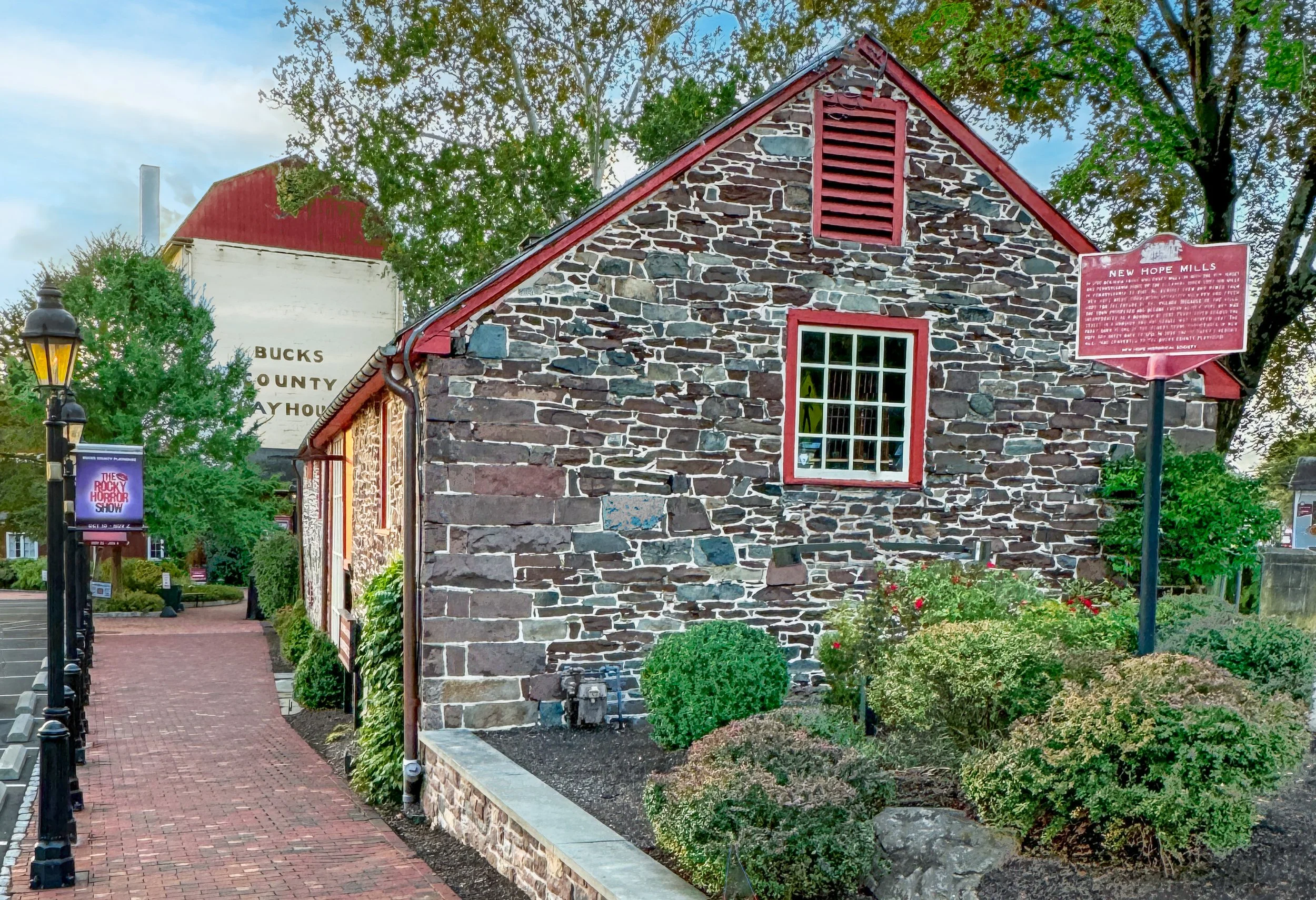The 1784 Parry Mansion
In New Hope
Built for Quaker Businessman Benjamin Parry
He is “The Father of New Hope.”
Above: The 1784 Parry Mansion in New Hope. The house presides over the town square as the historic home of the borough’s most prominent family of that era, the Quaker Parry family. Image source: Lee J. Stoltzfus
Benjamin Parry
”The Father of New Hope”
Was a Wealthy, Anti-War Quaker:
Above: The Father of New Hope, Benjamin Parry, appears in this engraving in a collarless Quaker coat, reflecting the plain-dressed ideals of his people. In the 18th century, Quakers were among the earliest settlers of Solebury Township, where they shaped much of the township’s early religious and cultural life.
Benjamin Parry was the most prominent businessman to settle in New Hope during the 1780s. His first acquisition was the Todd grist mill on the Ingham Creek. The foundations of this mill, built around 1767, now form part of the Bucks County Playhouse, which incorporates sections of Parry’s later expansions of the property. Image source: History of Bucks County, Pennsylvania, William Davis, 1905 Internet Archive.
Historical Sign in Front of the Parry Mansion:
Above: Historical marker in front of the Parry Mansion. Image source: Lee J. Stoltzfus
The Parry family can trace its ancestry to Caernarvonshire, Wales. Benjamin Parry married Jane Paxson, daughter of a wealthy neighboring Quaker family. Benjamin Parry and his younger brothers, David and Daniel, purchased numerous parcels throughout New Hope.
Benjamin Parry sold grain from his mill to markets along the east coast of the U. S., the West Indies, and in South America. He organized the Delaware Bridge Company and built a covered bridge across the Delaware River at New Hope in 1814. He also personally paid for the one-mile segment of the Delaware Division Canal which ran through New Hope.
The Parry Mansion
Constructed by Quaker Mathias Hutchinson
Who also built the Buckingham Friends Meeting House:
Above: The Buckingham Friends Meeting House, watercolor by Ranulph Bye. Image source: Buckingham Friends Meeting.
Benjamin Parry married Jane Paxson in 1787 in this Quaker meeting house. Master stone mason Mathias Hutchinson constructed this building in 1768. He also built the Parry Mansion.
Benjamin Parry gave the village of New Hope its present name. In 1790 his Coryell’s Ferry mill complex was destroyed by fire. Parry rebuilt the facility and named the new complex the “New Hope Mills.” The settlement adopted this name as well. When New Hope was incorporated as a borough in 1837 Benjamin Parry became the town’s first burgess.
Benjamin Parry:
He Built the Mill that Evolved into
The Bucks County Playhouse:
Above: The Bucks County Playhouse at dawn. Image source: Lee J. Stoltzfus
Benjamin Parry’s first grist mill in New Hope was located on the site of the Bucks County Play House. The former mill’s foundations now make up part of this theater. Parry’s historic milling machinery survives in the basement. The Parrys also owned six houses, stables, and a cooper's shop. In the 1790s they owned the only store in New Hope.
The 1751 Parry Barn
With the Theater in Background:
Above: The 1751 Parry barn in front of the Bucks County Playhouse. The barn served as stables for horses. The foundation of the Parry mill survives as part of the playhouse.
The 1751 Parry Barn
One of the Earliest Stone Structures in New Hope:
Above: Historical marker in front of the Parry barn. Image source: Lee J. Stoltzfus
The Quaker Parry Family in 1798
The Most Prominent Family in New Hope:
Above: Image source: New Hope Historical Society
In 1798 Benjamin Parry commissioned a map of property he owned in New Hope. This map reveals that the Parrys owned the grist mill whose foundations now are part of the Bucks County Playhouse. The Parry brothers also owned six houses, a store, stables, a cooper's shop and an unnamed shop. The Parry family owned the only store in town in 1798.
Above: The ice house at the Parry Mansion. The mansion remained in the Parry family until 1966. It is now the home of the New Hope Historical Society and is open to the public as a museum. Image source: Lee J. Stoltzfus
The Birth Record of Benjamin Parry in 1757:
Above: Birth record of Benjamin Parry in 1757. The Parry family emigrated from Caernarvonshire, Wales, in 1699 to seek freedom for their Quaker faith. The Parrys settled in Moreland Township, north of Philadelphia. Some descendants soon moved into Bucks County. Image source: Abington Monthly Meeting, Minutes, 1629 - 1812, Ancestry.com
Benjamin Parry’s Anti-War Quaker Faith:
Above: Image source: Internet Archive
Throughout Pennsylvania’s early history many Quakers refused to pay militia taxes because of their peace testimony. Their resistance came from the long-standing belief that any support for military activity conflicted with their religious principles. To these Friends, paying the militia tax meant contributing to violence, which their faith required them to avoid.
This resistance to warfare often led government officials to seize property such as livestock, household goods, or crops in place of payment of the militia tax. Meeting records show both the persistence of Quakers in standing up for their peace testimony and the financial hardships that sometimes followed.
New Hope, Bucks County
A Quaker History of Peace:
Above: Quaker civic leader Benjamin Parry, the Father of New Hope, AI image: Lee J. Stoltzfus after an engraving by E. G. Williams and Bro., History of Bucks County, Pennsylvania, William Davis, 1905 Internet Archive.
Links:












